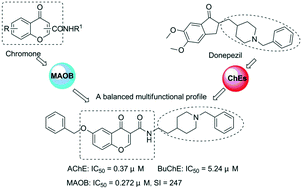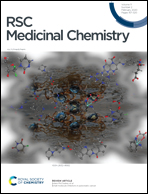Chromone and donepezil hybrids as new multipotent cholinesterase and monoamine oxidase inhibitors for the potential treatment of Alzheimer's disease†
Abstract
A series of chromone and donepezil hybrids were designed, synthesized, and evaluated as multipotent cholinesterase (ChE) and monoamine oxidase (MAO) inhibitors for the potential therapy of Alzheimer's disease (AD). In vitro studies showed that the great majority of these compounds exhibited potent inhibitory activity toward BuChE and AChE and clearly selective inhibition for hMAO-B. In particular, compound 5c presented the most balanced potential for ChE inhibition (BuChE: IC50 = 5.24 μM; AChE: IC50 = 0.37 μM) and hMAO-B selectivity (IC50 = 0.272 μM, SI = 247). Molecular modeling and kinetic studies suggested that 5c was a mixed-type inhibitor, binding simultaneously to peripheral and active sites of AChE. It was also a competitive inhibitor, which occupied the substrate and entrance cavities of MAO-B. Moreover, compound 5c could penetrate the blood–brain barrier (BBB) and showed low toxicity to rat pheochromocytoma (PC12) cells. Altogether, these results indicated that compound 5c might be a hopeful multitarget drug candidate with possible impact on Alzheimer's disease therapy.



 Please wait while we load your content...
Please wait while we load your content...